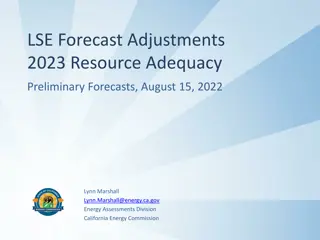ERCOT Public Resource Adequacy Reports Review May 2023
Review of ERCOT public reports highlights key findings such as reserve margin changes, new projects eligibility, and upcoming EPA regulations impacting fossil-fueled generation units. The reports cover capacity, demand, reserves, and seasonal assessment of resource adequacy for the summer of 2023. The analysis includes comparisons of reserve margin calculations and outlines scenarios for base, risk, extreme peak load, and unplanned thermal outages.
Download Presentation

Please find below an Image/Link to download the presentation.
The content on the website is provided AS IS for your information and personal use only. It may not be sold, licensed, or shared on other websites without obtaining consent from the author.If you encounter any issues during the download, it is possible that the publisher has removed the file from their server.
You are allowed to download the files provided on this website for personal or commercial use, subject to the condition that they are used lawfully. All files are the property of their respective owners.
The content on the website is provided AS IS for your information and personal use only. It may not be sold, licensed, or shared on other websites without obtaining consent from the author.
E N D
Presentation Transcript
CDR and SARA Review Pete Warnken Resource Adequacy ERCOT Public May 19, 2023
Capacity, Demand and Reserves Report ERCOT Public
Summer 2024 Reserve Margin, Component Changes November 2022 CDR to May 2023 CDR 3 ERCOT Public
CDR Highlights As a longer-term planning assumption, Large Flexible Loads do not consume power during the peak load hours (i.e., are fully curtailable when needed by ERCOT) The owner of one of the Kiamichi Switchable Generation Resource (150 MW) notified ERCOT that the unit would be serving SPP Includes a new supplemental tab that compares Reserve Margin calculations with a 9 PM version that accounts for lower solar production, lower load, and higher wind The 9 PM Reserve Margin is 8.8 percentage points lower than the traditional 5 PM Reserve Margin Two new planned natural gas projects became eligible for CDR inclusion since the November 2022 CDR (Remy Jade II Power Station 104 MW, and Sky Sealy 129 MW). Current CDR eligible planned thermal projects total 1,568 MW 4 ERCOT Public
CDR Highlights, continued On the Horizon: U.S. EPA pending/proposed regs that may impact the availability of fossil-fueled generation units: Federal Implementation Plan (FIP) for interstate transport of ozone-forming emissions ( Good Neighbor Plan ) Coal Combustion Residuals Standards Mercury and Air Toxics Standards Proposal to implement SO2 Best Available Retrofit Technology (BART) requirements for certain Texas generation units under the Regional Haze rule EPA proposed rule to control Greenhouse Gas emissions through changes to New Source Performance Standards and emission guidelines for existing generation units (issued May 8, 2023) 5 ERCOT Public
Summer 2023 Seasonal Assessment of Resource Adequacy (SARA) Report ERCOT Public
Base and Risk Scenarios Base & Moderate Risk Scenarios Extreme Risk Scenarios Extreme Peak Load Extreme Unplanned Thermal Outages Extreme Unplanned Thermal Outages Extreme Low Wind Total Installed Capacity High Peak Load High Unplanned Thermal Outages Low Wind and Solar Load and Resources Base Extreme Peak Load Peak Demand 83,412 86,801 83,412 83,412 88,526 88,526 86,801 Resources, Spring-rated Capacity Thermal (scenarios outage-adjusted) and hydro78,318 Capacity from Private Use Networks* Wind Solar Storage Non-Synchronous Ties Total Resources 64,724 2,869 10,427 12,636 447 850 91,954 64,724 2,869 10,427 12,636 447 850 91,954 61,335 2,869 10,427 12,636 447 850 88,565 64,724 2,869 2,894 9,263 447 850 81,047 64,724 2,869 10,427 12,636 447 850 91,954 58,551 2,869 10,427 12,636 447 850 85,781 58,551 2,869 61 12,636 447 850 75,415 9,575 37,747 16,130 3,544 1,220 146,534 Emergency Resources 0 0 0 4,577 0 4,577 4,577 Capacity Available for Operating Reserves (Less than 1,000 MW indicates risk of EEA3 Load Shed) 8,542 5,153 5,153 2,212 3,428 1,832 (6,809) * Reflects only the installed capacity used to deliver power to the ERCOT grid. 7 ERCOT Public
Base Scenario Waterfall Chart 8 ERCOT Public
Most Extreme Scenario Waterfall Chart 9 ERCOT Public
Large Flexible Loads For the peak demand forecast, 220 MW is the amount of stand- alone LFLs that are not expected to be curtailed for the summer peak demand hour Methodology description from the Long-Term Hourly Peak Demand and Energy Forecast methodology document: 220 MW = (1,500 MW + 700 MW growth by Summer 2023) x 10% Due to more recent information regarding LFL interconnections and behavior, ERCOT decided to update both the stand-alone and co- located using the same interim methodology for consistency 10 ERCOT Public
Large Flexible Loads, continued Interim methodology applied to all LFLs: Determined the 20 hours over each of the past three years with the lowest average Physical Responsive Capability For each hour, compared the LFL s historical Load Zone price with the Bitcoin mining breakeven cost If the market price is lower than the breakeven cost, then the load's peak summer consumption is the maximum observed consumption at the site according to internal project tracking If the market price is higher than the breakeven cost, then the LFL was assumed to be fully curtailed except for 3% of the load's maximum capability Average the consumption values for the 60 low PRC hours Resulting amounts are: 837 MW for stand-alone, 488 for co- located total of 1,325 MW Since the demand forecast includes 220 MW, this amount is deducted from 1,325 MW to avoid double-counting (1,150 MW) 11 ERCOT Public
Battery Storage Capacity Contribution Battery storage capacity contribution, 447 MW, based on SCED interval analysis of available discharge energy (minimum of State of Charge and High Ancillary Service Limit (HASL) for the 2022 summer hours that are expected to experience the most discharging, HE16-HE19 Not confident that the capacity contribution increases linearly with the large increase in installed capacity since the summer 2022 SARA 1,509 MW; as a result, did not scale-up the value based on expected summer 2023 capacity levels Battery storage energy is also accounted for in Responsive Reserve Service included as an EEA resource (Fast Frequency Response and some Primary Frequency Response) 12 ERCOT Public























